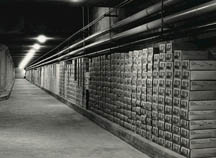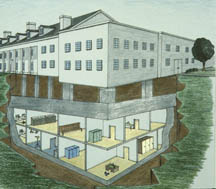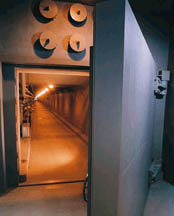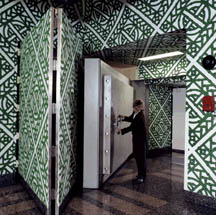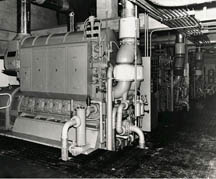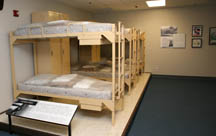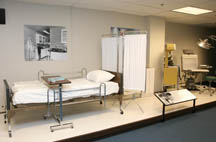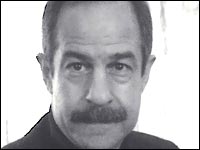|
Hidden in Plain View The incredible account of a betrayed US National secret. |
Click the star for The Greenbrier photo gallery
Note: Due to the current activities in the Bunker, Filming of any kind is prohibited. Our thanks to The Greenbrier for the photos included here.
|
Click image for larger view |
This is an incredible account of a huge, top secret, Cold War Fall-Out Shelter for the entire United States Congress. This Legislative Branch retreat, in case of nuclear war, was literally right under the feet of the fashionably elite in one of the most upscale, exclusive, five star-resorts in the world . . . The Greenbrier. A National Historic Landmark, it is set in the beautiful Allegheny mountains of West Virginia. In case of war, every Congressman, Senator, along with their staffs (but not their families) would be moved there to" continue government." If possible, |
|
with enough food and supplies
– even things like Vitalis (a popular 1950's hair tonic) to
"last comfortably." Radio and TV studios with murals to
give the feel of being in Washington were provided so that what
public was left would know there was still an operational central
government.
This structure, known simply as "The Bunker" was built just in time for the Cuban Missile Crisis but never used. But it was there – ready, prepared, manned, and secret – for more than 30 years. "The scope and broadness of the vision is jaw dropping!" said Robert |
|
The project was started in the 1950's, when children were trained in school to hide under desks and families were building fall-out shelters in their back yards, President Eisenhower was concerned that after a nuclear exchange - with Washington destroyed - chaos would follow. Who would govern? The State governments? If congress were not operating, the vacuum would be filled by a strengthened President who might morph into a dictator, or by the military.
Project
Greek Island, The Bunker
|
Bunker was the latter. It was code named "Project Greek Island" and was built in secret under The Greenbrier's new West Virginia Wing. It was under construction from 1958 to 1961. The shelter had 53 rooms on two levels measuring 112,544 square feet. Buried under 20'
to 60' of earth, it could withstand a modest nuclear blast approximately
15-30 miles away. It has four entrances with steel and concrete
doors built by the Mosler Safe Company. One weighed 25 tons. Two
entrances were large enough to accommodate trucks. |
|
behind a moveable screen. If the bunker were activated, this area would become the work area for Congressmen, Senators and their staff. There were two public meeting rooms off the exhibition hall. These
were used by The Greenbrier but upon activation, would become the
House and Senate. |
|
The kitchen had food for 60 days. It could feed 400 people at once so eating was to be done in shifts. The kitchen was fully equipped and, along with the serving areas, took up 7500 square feet. The 18 dormitories could sleep 60 people each on metal bunk |
||
|
beds. Each had a shower, toilets, and small lounge. The clinic covered 600 square feet and had 12 beds, an operating |
||
|
During its life, it was constantly maintained in a state of readiness. Communications, electronics, and mechanical equipment was updated as needed. Supplies were cycled to insure freshness. A complete TV and radio studio was equipped with modern |
The History
|
The Greenbrier is set in what was known in Colonial Days as the Midland Trail, a heavily-traveled pass through the mountains. This pass later became Rt. 60 and a railroad. I-64 now serves the area also. Several mineral springs were located along the route -- a convenient one day stage coach ride apart, they drew visitors for 229 years. At White Sulphur Springs a community of cottages grew into The Greenbrier we know today. During WWII The Greenbrier was taken over by the Government to hold enemy diplomats caught here when WWII was declared and held to insure a trade for our enterned diplomats in enemy countries. POW's became the next guests to enjoy the area: members of Rommel's |
The Reason The Greenbrier was Chosen
The Government already had a comfortable relationship with The Greenbrier. As you can see from the
| history, there was close cooperation for decades. And as Larry Mazey, the CEO of CSX IP said, it is a patriotic area. The people here in White Sulphur Springs can keep a secret. Both the people and The Greenbrier had a good track record. |
The people here in White Sulphur Springs can keep
a secret.
|
It was in the Area of Evacuation around Washington. It would become one of what was described by one official in the Office of Defense Mobilization as "a series of facilities that runs in an arc from the District of Columbia to Pennsylvania, out to Virginia and West Virginia and south to North Carolina."
The Greenbrier was privately owned so it wasn't controlled by the Executive Branch as a military base would be. It was felt that this would reduce any thought of too much power in the Presidents hands. Its very lack of military importance made it less likely to be a target.
It was nestled in a natural valley that would tend to block any blasts. It also had good transportation system, dating back to colonial days.
Keeping
The Secret
Many suspected something; few knew. Questions were sloughed off as unfounded
rumors by those in the know. Too many questions by employees was discouraged
. . . "not a good career move." They could also honestly say
that it wasn't a presidential bunker, a common rumor.
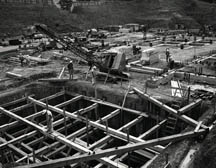 Construction of the West Virginia Wing providing cover for the excavation beneath it. Click image for larger view |
It helped that part of the bunker was in the Exhibition Hall and meeting rooms that were open to public. Their construction also served as an excuse for a large excavation. The excavation was so large that simple disposal of the dirt was a problem. The dirt ended up as a church parking lot across the street where a gully/hollow had been and enlarged a 9-hole golf course to 18 holes.
|
Current Use
"The Greenbrier resort provides a blend of classic Georgian architecture, exquisite cuisine, luxurious accommodations, numerous recreational activities and Southern hospitality."
Most of the remaining bunker is used by CSX IP, a subsidiary of CSX Railroad, for storage of archives and company records.
The Betrayal
Caution: This story contains obvious opinion
. . . mine.
In 1991 and early 1992 a free-lance reporter began snooping around. This
was not unusual but this guy was a little different. He soon snooped out
enough to expose this national secret and to render useless a very expensive
project. His name is Ted Gup.
| On May 31, 1992, The Washington Post published all the details. People at The Greenbrier and White Sulphur Springs were devastated. They had kept the secret - even their suspicions - for 35 years only to have this national security secret, broadcast to the world when one unscrupulous reporter outed it. Unscrupulous is my word, not anyone's at The Greenbrier although people there admitted to being devastated when Ted Gup published the secrets in the Washington Post magazine. FDR or Truman would have tried him as a traitor. In these times, however, he ends up as a professor in a liberal college. Ted Gup excused his |
Sources
Robert Conte, PhD, The Greenbrier Historian
Lynn Swann, Director of Public Relations
Linda Walls, Head Tour Guide
The History of The Greenbrier, America's Resort by Robert S. Conte PhD
|
Visitors since
June 6, 2000 |

